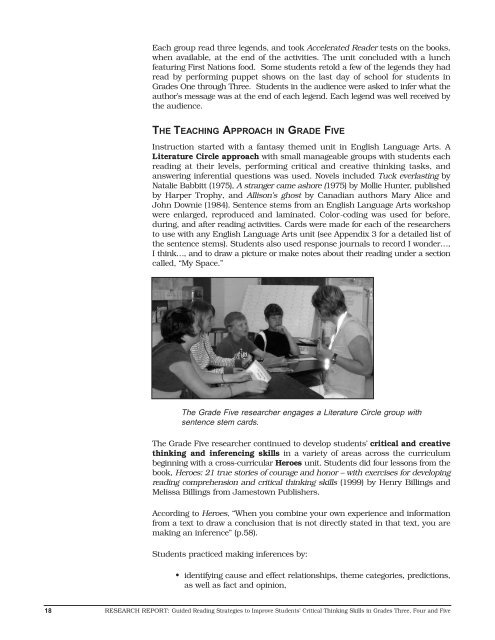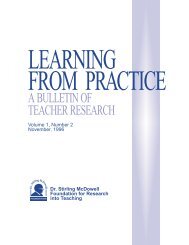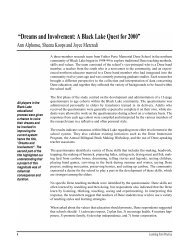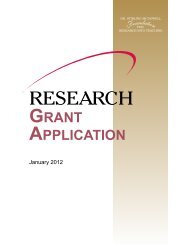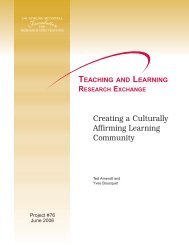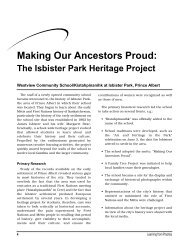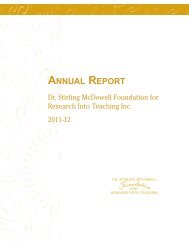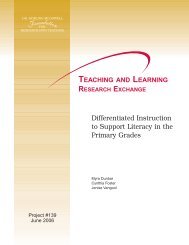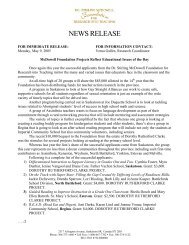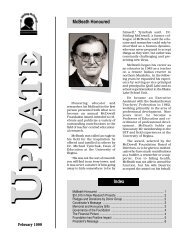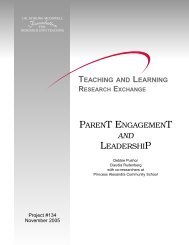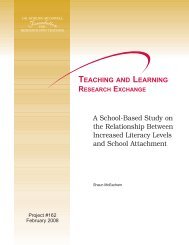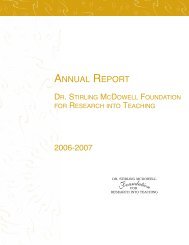Guided Reading Strategies to Improve Students - Dr. Stirling ...
Guided Reading Strategies to Improve Students - Dr. Stirling ...
Guided Reading Strategies to Improve Students - Dr. Stirling ...
- No tags were found...
You also want an ePaper? Increase the reach of your titles
YUMPU automatically turns print PDFs into web optimized ePapers that Google loves.
Each group read three legends, and <strong>to</strong>ok Accelerated Reader tests on the books,when available, at the end of the activities. The unit concluded with a lunchfeaturing First Nations food. Some students re<strong>to</strong>ld a few of the legends they hadread by performing puppet shows on the last day of school for students inGrades One through Three. <strong>Students</strong> in the audience were asked <strong>to</strong> infer what theauthor’s message was at the end of each legend. Each legend was well received bythe audience.THE TEACHING APPROACH IN GRADE FIVEInstruction started with a fantasy themed unit in English Language Arts. ALiterature Circle approach with small manageable groups with students eachreading at their levels, performing critical and creative thinking tasks, andanswering inferential questions was used. Novels included Tuck everlasting byNatalie Babbitt (1975), A stranger came ashore (1975) by Mollie Hunter, publishedby Harper Trophy, and Allison’s ghost by Canadian authors Mary Alice andJohn Downie (1984). Sentence stems from an English Language Arts workshopwere enlarged, reproduced and laminated. Color-coding was used for before,during, and after reading activities. Cards were made for each of the researchers<strong>to</strong> use with any English Language Arts unit (see Appendix 3 for a detailed list ofthe sentence stems). <strong>Students</strong> also used response journals <strong>to</strong> record I wonder…,I think…, and <strong>to</strong> draw a picture or make notes about their reading under a sectioncalled, “My Space.”The Grade Five researcher engages a Literature Circle group withsentence stem cards.The Grade Five researcher continued <strong>to</strong> develop students’ critical and creativethinking and inferencing skills in a variety of areas across the curriculumbeginning with a cross-curricular Heroes unit. <strong>Students</strong> did four lessons from thebook, Heroes: 21 true s<strong>to</strong>ries of courage and honor – with exercises for developingreading comprehension and critical thinking skills (1999) by Henry Billings andMelissa Billings from James<strong>to</strong>wn Publishers.According <strong>to</strong> Heroes, “When you combine your own experience and informationfrom a text <strong>to</strong> draw a conclusion that is not directly stated in that text, you aremaking an inference” (p.58).<strong>Students</strong> practiced making inferences by:• identifying cause and effect relationships, theme categories, predictions,as well as fact and opinion,18 RESEARCH REPORT: <strong>Guided</strong> <strong>Reading</strong> <strong>Strategies</strong> <strong>to</strong> <strong>Improve</strong> <strong>Students</strong>’ Critical Thinking Skills in Grades Three, Four and Five


